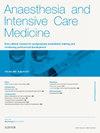血管内动脉瘤修复的麻醉
IF 0.3
Q4 ANESTHESIOLOGY
引用次数: 0
摘要
腹主动脉瘤(AAA)的手术修复可以通过开放或血管内入路进行;手术和患者因素决定了哪种方法最合适。血管内动脉瘤修复(EVAR)通常在专科中心进行,由外科医生、介入放射科医生和麻醉师组成多学科团队。这种方法的好处包括减少生理损伤,缩短住院时间和更有利的早期死亡率,但它也需要终身随访,中长期死亡率并不比开放式修复(OR)好。因此,英国国家健康和护理卓越研究所最初对推荐在选择性AAA修复中使用EVAR犹豫不决,但经过修订,现在可以考虑在开放式修复禁忌的情况下使用EVAR。事实上,大多数选择性AAA修复是在血管内完成的。EVAR患者通常比OR患者更合并症和更脆弱,因此全面的术前评估和优化是至关重要的。混合手术室通常位置偏远,且相关的辐射暴露会给麻醉师带来额外的挑战。可采用全身、区域或局部麻醉,每种麻醉各有利弊。术中处理可能因患者、麻醉和手术因素而异。具体考虑因素包括在潜在的大量失血之间提供平衡,同时也需要抗凝水平,支架部署周围的生理变化以及促进最佳成像。术后并发症通常很少,但患者需要终身随访,与OR相比,这是一种更具侵入性和昂贵的选择。本文章由计算机程序翻译,如有差异,请以英文原文为准。
Anaesthesia for endovascular aneurysm repair
Surgical repair of abdominal aortic aneurysms (AAA) can be done via an open or endovascular approach; surgical and patient factors determine which is most appropriate. Endovascular aneurysm repair (EVAR) is usually done in specialist centres with a multidisciplinary team involving surgeons, interventional radiologists and anaesthetists. Benefits of this approach include reduced physiological insult, shorter hospital stays and more favourable early mortality but it also requires lifelong follow-up, and mortality in the mid to long term is no better than open repair (OR). As a result, there was initial hesitancy by the UK National Institute for Health and Care Excellence to recommend EVAR in elective AAA repair but this was revised and can now be considered where open repair is contraindicated. Indeed, the majority of elective AAA repair is done endovascularly. Patients undergoing EVAR are usually more comorbid and frailer than OR patients and so comprehensive preoperative assessment and optimization is paramount. The often-remote location of, and associated radiation exposure in hybrid theatres can present additional challenges to the anaesthetist. General, regional or local anaesthesia can be employed, each with associated benefits and disadvantages. Intraoperative management can vary depending on patient, anaesthetic and surgical factors. Specific considerations include providing a balance between the potential for significant blood loss whilst also requiring a level of anticoagulation, the physiological changes around stent deployment and facilitating optimal imaging. Postoperatively complications are usually minimal but patients require lifelong follow-up, making it a more intrusive and expensive option compared to OR.
求助全文
通过发布文献求助,成功后即可免费获取论文全文。
去求助
来源期刊

Anaesthesia and Intensive Care Medicine
ANESTHESIOLOGY-
CiteScore
0.50
自引率
0.00%
发文量
152
期刊介绍:
Anaesthesia and Intensive Care Medicine, an invaluable source of up-to-date information, with the curriculum of both the Primary and Final FRCA examinations covered over a three-year cycle. Published monthly this ever-updating text book will be an invaluable source for both trainee and experienced anaesthetists. The enthusiastic editorial board, under the guidance of two eminent and experienced series editors, ensures Anaesthesia and Intensive Care Medicine covers all the key topics in a comprehensive and authoritative manner. Articles now include learning objectives and eash issue features MCQs, facilitating self-directed learning and enabling readers at all levels to test their knowledge. Each issue is divided between basic scientific and clinical sections. The basic science articles include anatomy, physiology, pharmacology, physics and clinical measurement, while the clinical sections cover anaesthetic agents and techniques, assessment and perioperative management. Further sections cover audit, trials, statistics, ethical and legal medicine, and the management of acute and chronic pain.
 求助内容:
求助内容: 应助结果提醒方式:
应助结果提醒方式:


